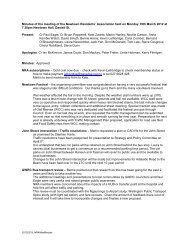Draft Town Belt Management Plan - Wellington City Council
Draft Town Belt Management Plan - Wellington City Council
Draft Town Belt Management Plan - Wellington City Council
Create successful ePaper yourself
Turn your PDF publications into a flip-book with our unique Google optimized e-Paper software.
the summit ridge. This suggests the original podocarp and broadleaf forest was cleared before<br />
European settlement as no stumps of recently cleared trees are depicted.<br />
By contrast, most of the western edge of the present-day city was covered by forest at the time of<br />
settlement. Heaphy (1879) records that in 1839 high trees grew on the flat towards Te Ahumairangi<br />
Hill (Tinakori Hill) and the sides and summit of Te Ahumairangi Hill “were densely timbered …<br />
the rata being conspicuous” 19 . There were native cultivations along the base of Te Ahumairangi<br />
Hill. Around upper Willis Street and Polhill Gully were high pine trees (native conifers) and some<br />
of the forest was partly cleared for native gardens.<br />
At the time of European settlement the forest on the eastern edge of the <strong>Town</strong> <strong>Belt</strong>, from Mt<br />
Victoria to Newtown, had largely disappeared through the fires used by Māori for land clearance.<br />
Probably 99.5 percent 20 of the original forest cover has now been lost. The plant associations on the<br />
<strong>Town</strong> <strong>Belt</strong> are young (less than 150 years old) and simple in structure with a limited diversity of<br />
native species. However, there are many naturalised plants and heavy infestations of weeds.<br />
Despite the lack of native species there are, in fact, around 600 plant species on the <strong>Town</strong> <strong>Belt</strong>.<br />
Only in the Botanic Garden are there remnants of the podocarp and broadleaf rainforests, which<br />
included kohekohe, hinau and titoki.<br />
From as early as the 1880s, but mostly between 1920 and 1940, a considerable area of the <strong>Town</strong><br />
<strong>Belt</strong> was planted with exotic conifer species and eucalypts. The paramount motive for this work was<br />
the desire to cover the denuded slopes that formed the backdrop to the new city. The councillors<br />
and citizens saw the <strong>Town</strong> <strong>Belt</strong> as something to embellish with trees for the purposes of recreation<br />
and the ornamentation of the city.<br />
These tree stands were very rarely thinned or managed and today they have a considerable<br />
understory of native shrub species in some areas.<br />
Areas not in native or exotic tree stands are either managed as grassed playing fields and passive<br />
recreation areas or they are scrub-covered. These areas of scrub, often gorse and broom, have the<br />
potential to regenerate into native bush if left undisturbed and kept weed-free and safe from fires.<br />
In 1998, following the adoption of the 1995 <strong>Town</strong> <strong>Belt</strong> <strong>Management</strong> <strong>Plan</strong>, a proactive tree-removal<br />
programme started with the removal of trees on <strong>Town</strong> <strong>Belt</strong> land adjacent to Norway Street in Te<br />
Aro. Nearly 30 hectares of trees have been removed and the area either revegetated with native<br />
plants or restored since then.<br />
The lack of native species complexity in the vegetation, and its physical discontinuity, follows<br />
through to a lack of native fauna. Only common bird species are present (the only numerous<br />
natives are fantail, grey warbler and silvereye), as well as eight species of introduced mammal, five<br />
species of lizard and only common insect species.<br />
The planting of exotic trees may have reminded early settlers of home. Now residents support<br />
native vegetation being established on <strong>Town</strong> <strong>Belt</strong> (91 percent of residents surveyed, 2009). They<br />
valued the protection of native habitat for birds and other animals (93 percent).<br />
5.2 Current ecological values<br />
The <strong>Town</strong> <strong>Belt</strong> is an easily accessible place where people can experience and view nature. It is also<br />
a corridor bringing nature into the <strong>City</strong>. The view of the <strong>Town</strong> <strong>Belt</strong>, the experience in it, and the<br />
habitat it provides, makes it an important part of the ecology of the <strong>City</strong>. There are over 180<br />
hectares of native-dominated vegetation on the <strong>Town</strong> <strong>Belt</strong>, most of it in an early stage of<br />
regeneration (see map on page 34). It is made up of native forest (106.6 ha), native<br />
19 “Charles Heaphy, “Notes on Port Nicholson and the Natives in 1839,” Transactions and Proceedings of the New<br />
Zealand Institute, 1879, Vol 12. 32-39<br />
20 Natural <strong>Wellington</strong>. A <strong>Plan</strong> to Preserve and Enhance the Natural Treasures of <strong>Wellington</strong> <strong>City</strong>, <strong>Wellington</strong> Branch,<br />
Royal Forest and Bird protection Society of NZ Inc, 1990<br />
34<br />
<strong>Draft</strong> <strong>Town</strong> <strong>Belt</strong> <strong>Management</strong> <strong>Plan</strong> October 2012





